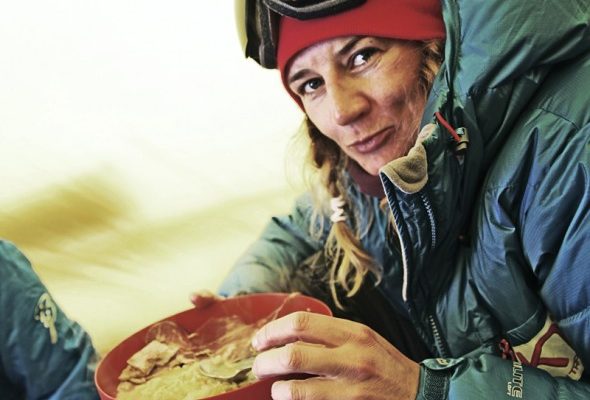I once went climbing with the comedian Ed Bryne, who told me he hated dehydrated food, because it tasted like shit “so I bought myself a dehydrator,” he said “so I could make my own food that tasted like shit”.
Personally I think people who complain about food are probably basing their culinary snobbery on what they would eat at home, or in a fancy restaurant, not the alternative. When I started climbing, only polar types or those on big-budget expeditions had dehydrated food, as the price was beyond the budget of any alpinist or backpacker. Back then the staples where porridge, muesli or a bar for breakfast, a Snickers bar for lunch, then couscous or noodles for dinner, which all in all was cheap, quick to cook and lightweight (all vital when you need to pack a week or two’s worth of food into a pack or haul bag). This approach, although ideal for routes of two or three days, didn’t scale up well for longer climbs, as the result was a hunger so deep you not only lost sight of the summit, thinking more of your belly, it also resulted in rapid weight loss and fatigue. On the Lafaile route in the Dru in 2002 we lost so much weight over 15 days, that I got a shock feeling my own body, the change so rapid it no longer felt like my own.
The first trip where we used dehydrated food was Greenland in 2006, where we ate the stuff for 27 days. There was never quite enough food, and so I lost a lot of weight, but the speed and ease of cooking, as well as sorting out portion control and rationing was a doddle. Since then, on all major routes I’ve forked out cash for good quality dehydrated meals, saving them for on the route, and adding pasta and porridge for pre- and post-climb food.
The beauty of these meals is that you just heat up the water in your pan (no need to ever put food in your pan), fill to the mark, then stick it in a jacket and leave for about eight minutes (the longer the better). A few bits of advice would be to buy a long-handled spoon (Alpkit make a great one) as it’s vital to stir well, so all the food is mixed with the water, plus a long spoon can be used more easily to get the food out of the corners. Empty packets also make great bowls for muesli, as they stand up and can be folded flat (again no need to dirty your pan), and when cleaned make great bowls for climbs when you’re not using dehydrated food. Lastly, make sure you try all menus before leaving, as some can be pretty rank unless you’re starving to death, and always include some Oxo cubes, spices and a small container of tobasco sauce (decant into a small plastic bottle, as the glass tobasco ones always break). Bon appetite!

Andy Kirkpatrick is one of Britain’s leading climbers, with sidelines as an award-winning writer, speaker and stand-up comedian. Read more at www.andy-kirkpatrick.com






